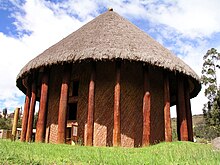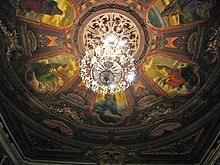
Barranquilla is the capital district of the Atlántico department in Colombia. It is located near the Caribbean Sea and is the largest city and third port in the Caribbean coast region; as of 2018, it had a population of 1,206,319 making it Colombia's fourth-most populous city after Bogotá, Medellín, and Cali.
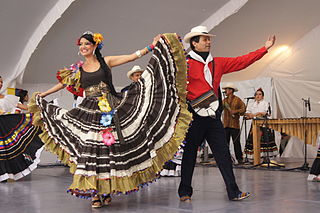
Many aspects of Colombian culture can be traced back to the early culture of Spain of the 16th century and its collision with Colombia's native civilizations. The Spanish brought Catholicism, the feudal encomienda system, and a caste system that favored European descendants.

Popayán is the capital of the Colombian department of Cauca. It is located in the Pubenza Valley in southwestern Colombia between the Western Mountain Range and Central Mountain Range. The municipality has a population of 318,059, an area of 483 km2, is located 1760 meters above sea level, and has an average temperature of 18 °C.

The National University of Colombia is a national public research university in Colombia, with general campuses in Bogotá, Medellín, Manizales and Palmira, and satellite campuses in Leticia, San Andrés, Arauca, Tumaco, and La Paz, Cesar. Established in 1867 by an act of the Congress of Colombia, it is one of the largest universities in the country, with more than 53,000 students. The university grants academic degrees and offers 450 academic programmes, including 95 undergraduate degrees, 83 academic specializations, 40 medical specialties, 167 master's degrees, and 65 doctorates. Approximately 44,000 students are enrolled for an undergraduate degree and 8,000 for a postgraduate degree. It is also one of the few universities that employs postdoctorate fellows in the country.

Luis Ángel Arango Library is a public library located in Bogotá, Colombia. It is one of the largest and most important libraries in the world. It was founded in 1958 as a small library with a few books on economics, currently its collection has about 2'000.000 works. Today the library has been expanded and occupies two entire city blocks spanning about 45,000m². Its collection has grown to become the country's premier library and has come to be considered the most important public library in Latin America, and one of the most visited in the world. It has over 1.1 million books and seating for 1900 readers; it received 6.7 million visitors in 2008. The library is named after the lawyer and businessman Luis Angel Arango, the general director (Governor) of the "Banco de la Republica" in Colombia from 1947 to 1957, and a champion of culture and literature for all. The library is part of the cultural affairs wing of Colombian Central Bank, Banrepcultural network, which today runs 23 additional libraries, cultural centers and museums across Colombia.

The carnival in Colombia was introduced by the Spaniards. The Colombian carnival has incorporated elements from European culture, and has managed to syncretise, or re-interpret, traditions that belonged to the African and Amerindian cultures of Colombia. There is documentary evidence that the carnival existed in Colombia in the 17th century and had already caused concern to the colonial authorities, who censored the celebrations, especially in the main centers of power such as Cartagena, Bogotá and Popayán. The carnival, therefore, continued its evolution and re-interpretation in the small and at that time unimportant towns where celebrations did not offend the ruling elites. The result was the uninterrupted celebration of carnival festivals in Barranquilla, and other villages along the lower Magdalena River in northern Colombia, and in Pasto, Nariño in the south of the country. In modern times, there have been attempts to introduce the carnival in the capital, Bogotá, in the early 20th century, but it has always failed to gain the approval of authorities. The Bogotá Carnival has had to wait until the 21st century to be resurrected, this time, by the authorities of the city. Colombia is recognized by its large variety of festivals, carnivals and fairs. Most towns have their own, ranging from those celebrating coffee to the ones held in honor of the town's Saint feast. The common characteristics of the festivals are the nomination of a beauty Queen and the setting up of public dance floor.

Caracol Radio is one of the main radio networks in Colombia. Founded in Medellín in 1948 when La Voz de Antioquia station acquired the 50% of Emisoras Nuevo Mundo, based in Bogotá.
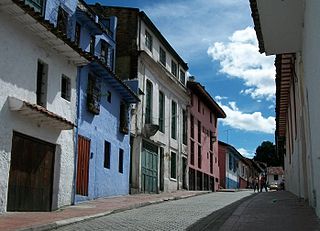
La Candelaria is the 17th locality of Bogotá, Colombia. A historic neighborhood in the city's downtown, it is the equivalent to the Old City in other cities. The architecture of the old houses, churches and buildings has Spanish Colonial Baroque, and art deco styles. It houses several universities, libraries and museums.

Santiago Martínez Delgado (1906–1954) was a Colombian painter, sculptor, art historian and writer. He established a reputation as a prominent muralist during the 1940s and is also known for his watercolors, oil paintings, illustrations and woodcarvings.

The contribution of travel and tourism to GDP was US$5,880.3bn in 2016. Tourism generated 556,135 jobs in 2016. Foreign tourist visits were predicted to have risen from 0.6 million in 2007 to 4 million in 2017. Responsible tourism became a peremptory need for Colombia because it minimizes negative social, economic and environmental impacts and makes positive contributions to the conservation of natural and cultural heritage.

Colombian art has 3500 years of history and covers a wide range of media and styles ranging from Spanish Baroque devotional painting to Quimbaya gold craftwork to the "lyrical americanism" of painter Alejandro Obregón (1920–1992). Perhaps the most internationally acclaimed Colombian artist is painter and sculptor Fernando Botero (1932).
Rogelio Salmona was a French Colombian architect. He was noted for his extensive use of red brick in his buildings and for using natural shapes like spirals, radial geometry and curves in his designs. During the latter part of his life, Salmona gained renown thanks to awards like the first prize at the 1986, 1988, and 1990 Colombian Architecture Biennials, and the Alvar Aalto Medal in 2003. His works are highly representative of Colombian architecture at the end of the twentieth century.
Access to the Internet in Colombia shows a marked increase during the last few years. As of September 2009, the web connections surpassed two million, as compared with an estimated total of 900,000 Internet subscribers by the end of 2005. The current figure equated to 17 million Internet users, plus 3.8 million mobile internet users, or 38.5 percent of the 2009 population, as compared with 4,739,000 Internet users in 2005, or 11.5 percent of the 2005 population. Colombia had 581,877 Internet hosts in 2006. This represents an overall growth of 54 percent each year, the highest in Latin America. Although as many as 70 percent of Colombians accessed the Internet over their ordinary telephone lines, dial-up access is losing ground to broadband. In 2005 Colombia had 345,000 broadband subscriber lines, or one per 100 inhabitants. In 2006 the number of personal computers per 1,000 people increased to an estimated 87 per 1,000 inhabitants, a rate still below that in other large Latin American economies. As of 2009, Colombia duplicated the number of personal computers reaching 26.3 percent, as compared with the rest of Latin America which showed a decreasing trend.

Free University of Colombia, also called Unilibre, is a nonsectarian, coeducational, private and nonprofit university based in Bogota, Colombia, with six satellite campuses located in Cali, Barranquilla, Pereira, Cartagena, Cúcuta, and Socorro. It is considered one of Colombia's most comprehensive universities, receiving a high quality accreditation from the Ministry of Education for 4 years, and offers sixty-seven degree programs at the undergraduate level and one hundred sixty-three graduate level programs.
The districtsof Colombia are cities that have a feature that highlights them, such as its location and trade, history or tourism. Arguably, the districts are special municipalities.

The Episcopal Conference of Colombia is an administrative institution and permanence of the Catholic Church, composed of all the bishops of the dioceses of Colombia in a college, in communion with the Roman Pontiff and under his authority to exercise set of certain pastoral functions of the episcopate on the faithful of their territory under the rule of law and statutes, in order to promote the life of the Church, to strengthen its mission of evangelization and respond more effectively to the greater good that the Church should seek to men.
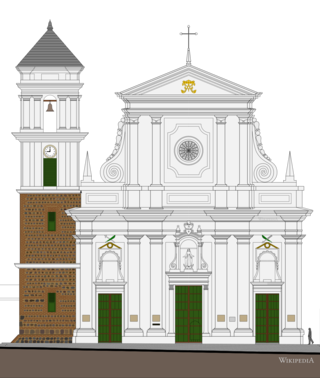
The Cathedral Basilica of the Immaculate Conception also called Santa Fe de Antioquia Cathedral It is a cathedral church of Catholic worship dedicated to the Virgin Mary under the title of the Immaculate Conception. The building is located on the northeastern side of the main square of the town and city of Santa Fe de Antioquia (Antioquia) in the South American country of Colombia. The cathedral is the principal church of the Roman Catholic Archdiocese of Santa Fe de Antioquia, seat of the Archbishop and Metropolitan Chapter.
